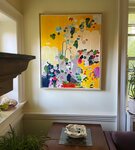Our clients sometimes look online for art. And that can be fine, but it can also mean they wind up with no connection to the story, or origins of the work.
This item is available in full to subscribers.
We have recently launched a new and improved website. To continue reading, you will need to either log into your subscriber account, or purchase a new subscription.
If you are a digital subscriber with an active subscription, then you already have an account here. Just reset your password if you've not yet logged in to your account on this new site.
If you are a current print subscriber, you can set up a free website account by clicking here.
Otherwise, click here to view your options for subscribing.
Please log in to continue |

Our clients sometimes look online for art. And that can be fine, but it can also mean they wind up with no connection to the story, or origins of the work.
David Shrigley’s “Shrig Shop,” for instance, is an example of great poster art. You see it. You get it. For art that is intended to be looked at and appreciated for potentially a lifetime, a connection to the spirit in which the piece was created lends a tremendous amount to how much we relate to and value the work.
Recently, I was walking in East Mt Airy with my sister-in-law and happened to see an "Open Studio" sign. We went in and ended up spending the better part of the afternoon with the artist Julie Zahn.
I had noticed her “open studio” sign because I was transfixed by all the unusual perennial plantings spilling from her front entry walkway, which is where we started our tour.
Julie led us through her large stone home, which has much of the original walnut woodwork intact, including upstairs rooms filled with racks of art. Her home is beautifully decorated with her own art.
From the house, Julie led us through a tall and wild back garden to her studio, which is located in an old stone garage with a high ceiling. The bright and welcoming colors of Julie’s work fill the space. And the garden we passed through to get there was full of plants that attract birds, a central part of Julie’s work. During the pandemic she created 100 works of art with birds in them.
Formally trained at the Pennsylvania Academy of the Fine Arts, Julie also studied printmaking for a year in Kyoto on a travel scholarship. She works in mixed media, including painting, drawing, woodcut printing, collage and Katazome or Japanese stencil dyeing.
Katazome uses a resist paste made of rice flour and defatted rice bran spread through a stencil. Like the wax in the Ukrainian egg decorating tradition of Pysanky, the paste keeps the pigment from saturating the paper as layers of wash and pigment are applied. The final step is to remove the paste by soaking the piece in water, revealing what it has preserved.
Julie Zahn is the daughter of Ann Zahn, a well-established figure in the Washington DC printmaking scene. Ann Zahn was a founding member of the Washington Printmakers Gallery. After she opened the Printmakers' Workshop in 1977, a large group of area printmakers studied with her and worked there daily for many years. Ann died in late 2020 and as this article is being written Julie is archiving her mother's work in the studio she worked in since 1965.
Last year Julie's work was featured at Awbury Arboretum, a perfect venue for her work. Her pieces are like looking out of a window to a garden on a sunny day. While her work is uniquely her own, at the same time it honors the history and the tradition of printmaking it is deeply steeped in.
We hope anyone who is local can find the time to make an appointment to see her studio in person – and have the opportunity to be able to soak in the environment from which the work was made. Because when you visit an artist’s studio, and connect with the person who made the work that speaks to you, you just may end up with walls that deliver a feeling of personal meaning and warmth, in addition to just looking good.
Julie can be contacted on her website: www.juliezahn.net
Val Nehez is the owner and principal designer at Studio IQL in East Falls. You can find her at studioiql.com and on Instagram at @studio_iql or @quickandlovely_design for smaller projects.